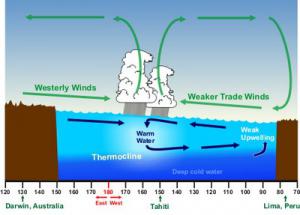ResilienceComing El Nino could replenish Calif.’s aquifers – or ravage vulnerable infrastructure
When respected climatologists describe this winter’s warming of tropical Pacific waters as a Godzilla El Nino event, they might be onto something. The science fiction monster’s signature move is to emerge from the ocean and destroy structures built by hapless humans. Many of the necessary plot elements are in place for El Nino to similarly wreak havoc in the Golden State in the coming months, says an expert.

Diagram of El Nino's structure // Source: commons.wikimedia.org
When respected climatologists describe this winter’s warming of tropical Pacific waters as a Godzilla El Nino event, they might be onto something. The science fiction monster’s signature move is to emerge from the ocean and destroy structures built by hapless humans. Many of the necessary plot elements are in place for El Nino to similarly wreak havoc in the Golden State in the coming months, says an expert in climate extremes at the University of California, Irvine.
“California is in year four of a severe drought,” says Amir AghaKouchak, assistant professor of civil & environmental engineering at the University of California, Irvine (UCI). “Earthen infrastructure around the state is dried out to the point of cracking. If a sudden overabundance of water from El Nino rains gets in those cracks, vital dams, levees and roadways can fail.”
UCI reports that an El Nino is not destructive in and of itself. It is not a discrete weather event such as a hurricane or a tornado. It’s a climate phenomenon centering on above-average sea surface temperatures in the tropical Pacific Ocean — specifically, at least half a degree Celsius above normal for three or more months. The warming condition can lead to significantly higher rainfall in the southern United States, among other effects.
Some El Ninos are incredibly powerful, while others come and go without much impact. Big events in 1982-83 and 1997-98 caused flooding, infrastructure damage and lots of headaches for Southern California commuters. The current El Nino has the potential to at least equal those.
In fact, average sea surface temperatures in the tropical Pacific for August, September and October of this year were 1.7 degrees Celsius above average, and the National Oceanic & Atmospheric Administration says there’s about a 95 percent chance that an El Nino will make its presence felt well into California’s winter rainy season.
This should come as welcome news to thirsty Californians, but there are risks. “Obviously, flooding is a big concern,” says AghaKouchak. “That can affect homes, roads, transportation and other infrastructure.”
He says the key question is whether California will get heavy deluges all at once or moderate precipitation spread out over the winter months. “If we get a good amount of rain over a long period of time, it would be much better for drought recovery and pose less danger to infrastructure,” AghaKouchak says. “If we get a lot of rain over a very short period of
